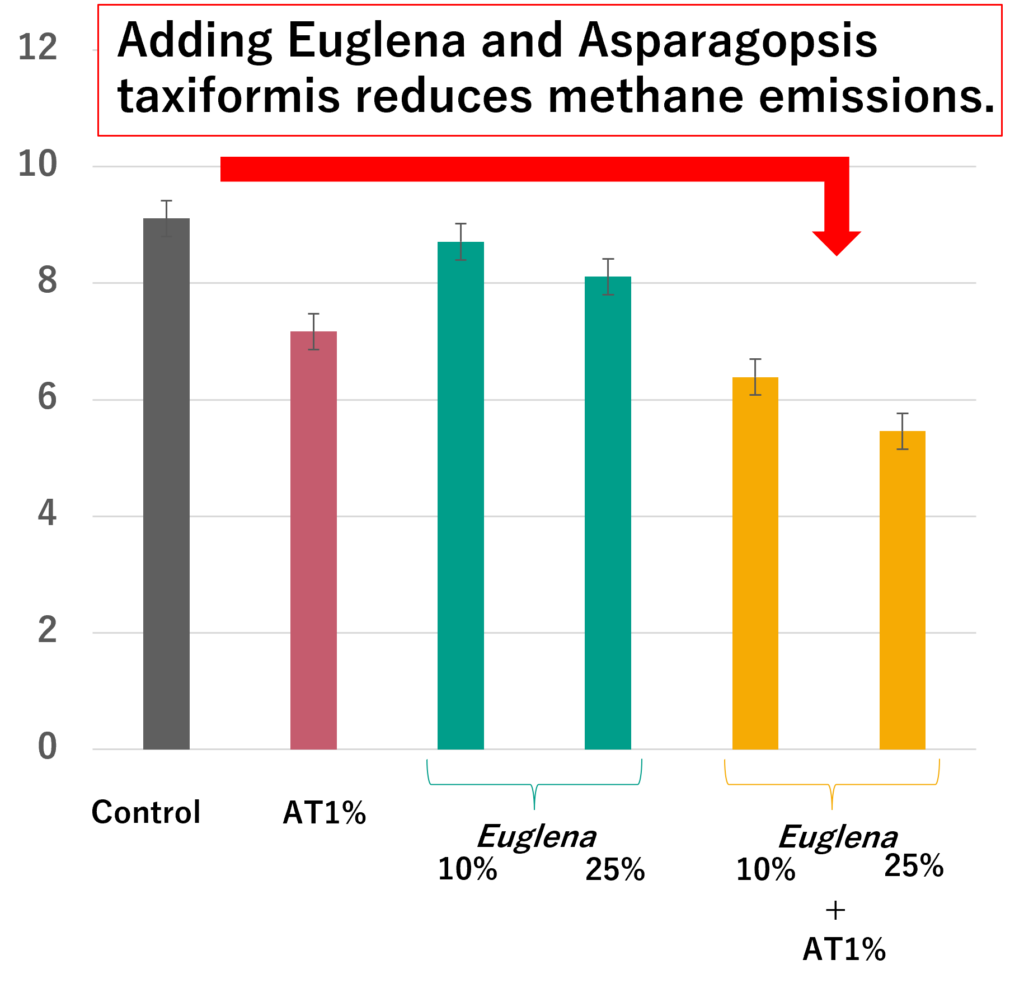
A mixed feed containing the microalgae Euglena and a type of seaweed known as “Asparagopsis taxiformis” has been found to reduce methane emissions from ruminant livestock.
Euglena Co., Ltd. has confirmed through research conducted in collaboration with Professor Takehiro Nishida from the Department of Life and Food Science at the Hokkaido University of the National University Corporation Hokkaido University of Veterinary Medicine that a mixed feed containing the microalgae Euglena and a type of seaweed known as "Asparagopsis taxiformis"※1 can reduce methane※3 emissions from ruminant livestock※2 without compromising their health. This research has been published in the academic journal "animals"※4.
※1 Asparagopsis taxiformis: A type of red seaweed known as Kagike-nori in Japanese.
※2 Ruminant livestock: Domesticated animals like cattle, sheep, and goats that are characterized by their four-chambered stomachs and the process of regurgitating and rechewing their food.
※3 Methane: CH4, a potent greenhouse gas that has a significant impact on climate change, ranking second only to carbon dioxide. Its emissions come from various sources, including wetlands, rice paddies, livestock, and natural gas production.
※4 Link to the publication: https://www.mdpi.com/2076-2615/13/5/796
■Background:
Livestock farming is an essential industry for supplying protein to humans, but it faces challenges such as environmental impact and shortages and price increases of feed ingredients in recent years. Finding sustainable feed ingredients with lower environmental impact is a pressing need. Among these challenges, the substantial methane emissions from ruminant livestock, including cattle, during the digestion of feed have become a significant concern. Methane is known to contribute to about 5% of total greenhouse gas emissions, making its reduction a crucial issue in combating climate change.
As a solution, algae have been increasingly considered as one of the options to reduce methane emissions from ruminant livestock. Previous studies have demonstrated the methane-reducing effect of Asparagopsis taxiformis, primarily attributed to the presence of a substance called bromoform. However, concerns have arisen about the potential impact on the composition of volatile fatty acids (VFA), a major energy source for livestock, when Asparagopsis taxiformis is included in feed at higher levels.
Euglena, on the other hand, has also shown its potential in reducing methane emissions when fed to ruminant livestock※5. Euglena is rich in various nutrients such as protein, lipids, carbohydrates, vitamins, making it a promising alternative or supplement to conventional feed ingredients like soybean, corn, and wheat.
In this study, a combination of Euglena and Asparagopsis taxiformis was investigated as a feed option with considerations for both livestock health and methane emission reduction.
※5 News release from April 5, 2017: "Confirmation of the effect of reducing methane emissions by partially replacing feed for ruminant livestock with microalgae Euglena" https://www.euglena.jp/news/20170405-2/
■Research Methods and Results:
In this research, the following feed combinations were prepared:
- Feed with 1% Asparagopsis taxiformis addition
- Feed with partial substitution of Euglena (10%, 25%)
- Feed with 1% Asparagopsis taxiformis addition and partial substitution of Euglena (10%, 25%)
The gas composition changes after immersing these feeds in stomach fluid collected from cows were observed to evaluate their impact on methane production and other factors. The results showed that compared to standard feed, feed with 1% Asparagopsis taxiformis (1) reduced methane emissions by 21%, (2) showed 4% reduction (Euglena 10%) and 11% reduction (Euglena 25%) in methane emissions, and (3) demonstrated a significant reduction of 29.9% (Asparagopsis taxiformis 1%, Euglena 10%) and 40.0% (Asparagopsis taxiformis 1%, Euglena 25%) in methane emissions (Figure 1).

Furthermore, the primary energy source for ruminant livestock is volatile fatty acids (VFA) produced in the first stomach. The composition of VFA is known to be influenced by the feed. To assess any potential health impacts on cows, feeds with various combinations were prepared:
- Feed with Asparagopsis taxiformis addition (1%, 5%)
- Feed with partial substitution of Euglena (10%, 25%)
- Feed with 1% Asparagopsis taxiformis addition and partial substitution of Euglena (10%, 25%)
- Feed with 5% Asparagopsis taxiformis addition and partial substitution of Euglena (10%, 25%)
After adding these feeds to stomach fluid, the levels of volatile fatty acids were measured, and the health impact on cows was evaluated. The results showed that a significant reduction in volatile fatty acids (VFA) was observed when 25% Euglena was substituted (7), while the other conditions had little to no adverse effects on the cows (Figure 2).

These research findings indicate that a combination of 1% Asparagopsis taxiformis and up to 25% Euglena in ruminant animal feed can contribute to reducing methane emissions without harming the health of cattle, highlighting the potential of these ingredients as raw materials for alternative feeds.
In the future, Euglena Co., Ltd. will continue to ensure the safety of Euglena as a feed ingredient and conduct research to enhance the value-added benefits of feed utilization, working toward the commercialization of feed usage.
